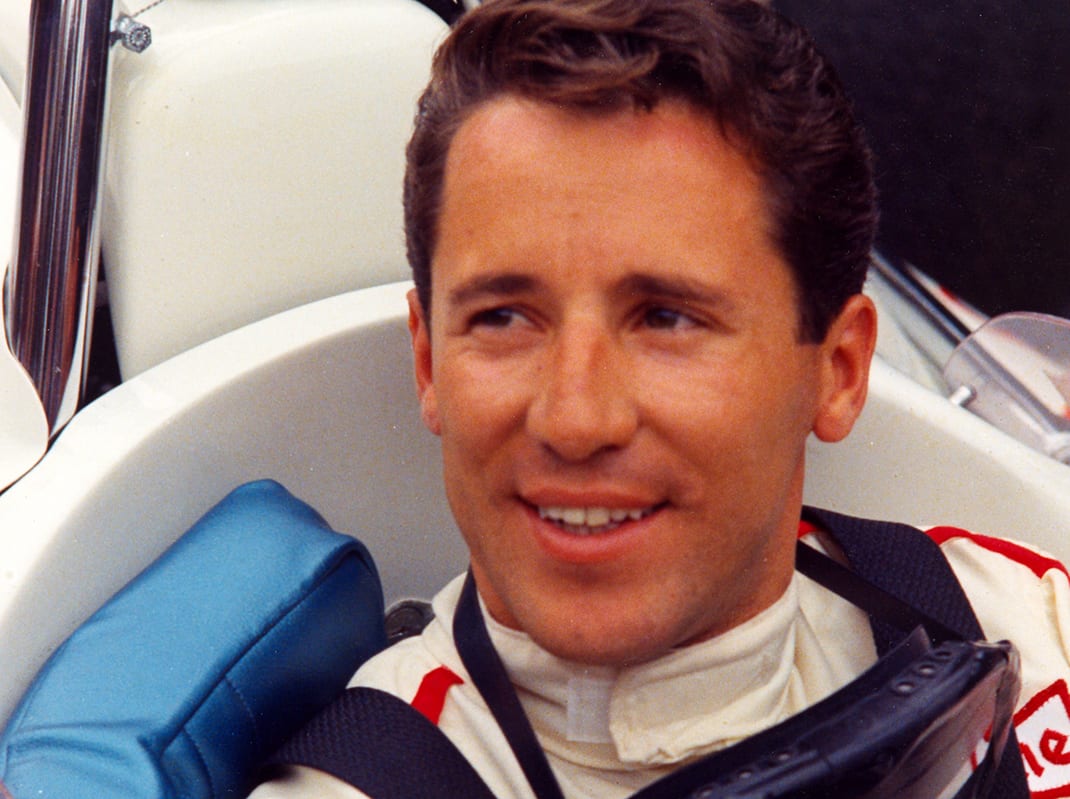Some people love the old joke about the young race fan who grows up believing the last four words to the national anthem are “Gentleman, Start Your Engines.”
Others don’t see the humor in that. Maybe it all comes down to personal experience.
In July 1964, Johnny Rutherford was standing near Mario Andretti on the grid at New Jersey’s Trenton Speedway. On tap was a 150-mile Indy car race. Rutherford was starting 14th. Andretti, three rows further up, was in his maiden race with the Dean Van Lines team. Chief mechanic Clint Brawner and his assistant, Jim McGee, were performing the usual last-minute checks as the first notes of “The Star-Spangled Banner” rang out.
In those days, before TV coverage turned everything into a pose, pre-race formalities were for spectators. For the combatants, the work went on.
“McGee was hammering on the wheel nuts, the old spinner type,” recalled Rutherford. “Mario, an immigrant, was standing there at attention. McGee kept banging the wheels as the national anthem played. Mario turned his head, just slightly, and in a thick Italian accent — much thicker than how he sounds today — said, ‘Jimmy! Jimmy! Don’t bang!’”
The anthem was sacred to Andretti, who had only been in the United States for nine years. He arrived in New York on June 16, 1955, a Thursday, just past sunrise. Already, the weather was out of a tourism brochure: blue skies, temps in the 60s, climbing toward a forecasted high of 80. Mario would always remember the day being “clear and sunny, just like in the movies.”
Today, so much of his life is a highlight reel: the four Indy car titles, the 1967 Daytona 500 win, the Indianapolis 500 victory in 1969 — jeez, 50 years ago — and the 1978 Formula One world championship. In June 1955, he couldn’t dream of the fame and fortune he would find.
He was 15 years old and staring at the Statue of Liberty from the deck of an ocean liner, the 668-foot Conte Biancamano. To his right, Manhattan’s skyscrapers glistened. But Mario was not smiling.
On board with him were his twin brother, Aldo, and their sister, Anna Maria, who turned 21 that very day. They’d sailed from Genoa, Italy, in the company of their parents, Alvise Luigi “Gigi” Andretti and his wife, Rina. Their journey over the blue Mediterranean, through the Strait of Gibraltar and across the Atlantic took 10 days.
Gigi and Rina were searching for a new life. The one they’d left had dissolved into no life at all. Before World War II, Gigi was caretaker for several farms and vineyards in Montona, on Italy’s Istrian peninsula, and the family lived comfortably.
But when the war ended and Europe’s borders were re-drawn, Istria belonged to communist Yugoslavia. Their freedom stolen, their wealth stripped away, 350,000 residents shuffled out of the region in what history books call the Istrian exodus.
Mr. and Mrs. Andretti, their kids and Rina’s parents were part of that diaspora. They spent several days in a camp in Udine, Italy, before being assigned to a displaced-persons compound in Lucca. There, the Andrettis were one of 17 families sharing a large room, with blankets for walls.
Eventually, they were given two tiny, connected rooms. The grandparents took one; in the other, Anna Maria had her own small bed, while Mario and Aldo shared the upper tier of a bunk bed, their parents below them.
Those crowded quarters were the family home for seven years. Next time you hear some race var driver talk about how he came from nothing, think about Mario Andretti in that bunk, in a building filled with strangers, in a place that wasn’t home.
But he and Aldo had spirit. In Lucca, they hung out at an auto repair shop owned by Sergio Seggiolina and Antonio Biagini, who allowed the teenagers to park the cars their customers dropped off. The men introduced the young Andrettis not only to the steering wheel, but also to the race car. They took the boys to the 1954 Italian Grand Prix at Monza, where they marveled at Alberto Ascari and his blood-red Ferrari. And early in 1955, Sergio and Antonio brought the twins to Florence so they could glimpse the passing Mille Miglia, Italy’s storied open-road race.
“It was as if I was living for the first time,” Mario told his biographer, Bob Collins.
His excitement was short-lived. That same spring, Gigi Andretti announced the family would leave for America. To Mario and Aldo, the news was devastating. In the days leading up to the trip — and during the voyage itself, Mario told writer Ed Hinton — one would whisper to the other, “No corse in America.” No racing in this new home of ours. Hence the lack of smiles as their ship idled past Lady Liberty.
But to Gigi Andretti, the sunlight bouncing off those Manhattan windows looked like gold at the end of a rainbow. Clearing immigration, he and his family traveled 80 miles west to Nazareth, Pa., home of Rina’s uncle Tony, who’d sponsored their immigration. Gigi took a job at Bethlehem Steel.
On the family’s first Sunday in Pennsylvania, Aldo was in bed with a headache when Mario bounded up the stairs, claiming he’d heard the rumble of racing engines. Aldo sprang out of bed and the two of them were out the door, chasing the noise.
It drew them to Nazareth Speedway, a half-mile oval of hard-packed dirt, around which hulking jalopies were sliding.
Mamma Mia! Corse in America! Through sheer, dumb luck, they had landed in a race-track town.
